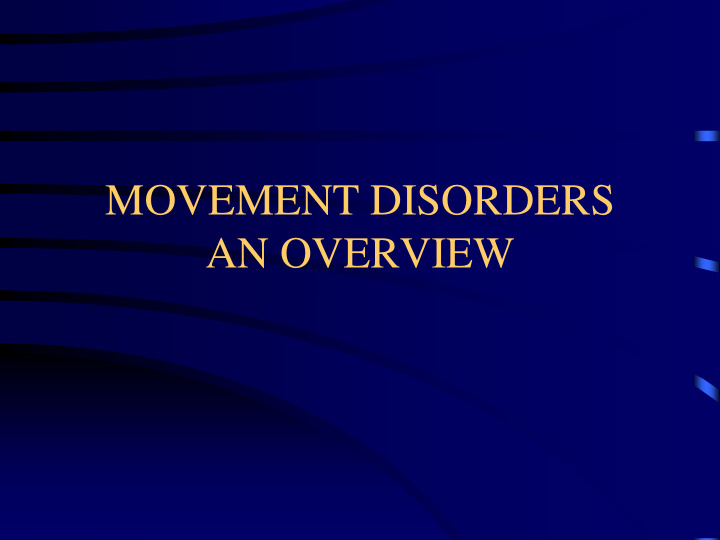



MOVEMENT DISORDERS AN OVERVIEW
THE SPECTRUM OF MOVEMENT DISORDERS • Akinetic-rigid syndromes/ Parkinsonism • Tremor • Dystonia • Athetosis • Chorea • Ballism • Tics • Myoclonus
THE AKINETIC -RIGID SYNROMES • Idiopathic Parkinson’s Disease • Parkinsonism( Drug induced) • Parkinson’s Plus Syndromes( PSP, Multiple System Atrophy, Corticobasal Ganglionic Degeneration)
IDIOPATHIC PARKINSON’S DISEASE • Degenerative disease of the Basal ganglia affecting people in middle to late life • Mean age of onset 55-60 years • Younger onset in familial cases • Possible male predominance
IPD 3 - CARDINAL FEATURES • Tremor • Rigidity • Bradykinesia • Disturbance in posture or equilibrium
IPD 4 - TREMOR
IPD 5 - RIGIDITY
IPD 8 - AETIOLOGY • Cause unknown • Presumed combination of genetic susceptibility and environmental factors • Familial Parkinson’s Disease has provided much information • genes identified in Familial Parkinson’s Disease
PATHOGENESIS • Genetic/environmental factors trigger abnormal protein folding • Leads to accumulation of toxic protein products within the Dopaminergic neurons in the Nigrostriatal pathway • Leads to mitochondrial damage (Complex 1) and cell death • Nigrostriatal damage leads to imbalance in Basal Ganglia circuitry
TREMOR • Defined as a rhythmic oscillation of a body part. • Resting, postural, intention • Typical resting tremor seen in Parkinson’s Disease • Typical intention tremor - Cerebellar disease • Typical Postural and action tremor - Essential tremor
DYSTONIA • Disorder characterised by sustained muscle contractions which frequently cause twisting and repetitive movements or abnormal postures • May be focal or generalised • Focal eg Blepharospasm, Torticollis • Generalised viz Idiopathic Torsion Dystonia
CHOREA • Irregular ,unpredictable,brief jerky movements that flit from one part of the body to another in a random sequence. • Sydenhams Chorea • Huntington’s Chorea • Wilson’s Disease
TIC DISORDERS • Abrupt ,transient ,stereotypical, co- ordinated movements which vary in intensity and occur at irregular intervals • Tics may be motor or vocal • Classic example is Tourette’s Syndrome
BALLISM • These movements are wide in amplitude,violent, flinging or flailing in nature • Usually unilateral -- Hemiballismus • Usually caused by lesion in the Subthalamic Nucleus
MYOCLONUS • Defined as sudden,brief shock-like involuntary movements • Wide range of clinical patterns • May be Physiological, Epileptic, or part of a progressive or static enchephalopathy
DRUG THERAPY
LEVODOPA 1 • Remains the Gold Standard • Use is limited by motor complications • Effective against tremor,rigidity and bradykinesia • Administered with a DDI • Regular and CR preparations
LEVODOPA 2 MOTOR COMPLICATIIONS • Motor fluctuations • Dyskinesias • Occur in 50-90% of patients on Levodopa for 5-10 years
LEVODOPA 3 MOTOR FLUCTUATIONS • Occur late in disease • Clinical response becomes unpredictable • Latency to onset of effect increases • May have rapid fluctuations between “On”and “Off ” periods
• Involuntary movements in response to Levodopa therapy • Peak dose, end-of -dose or both • Usually Choreiform,Dystonic,or Myoclonic • Tend to occur with motor fluctuations
DOPAMINE AGONISTS 1
COMT INHIBITORS
OTHER DRUGS
ANTICHOLINERGICS • Limited use • Younger patients with tremor as the dominant symptom • Useful if patient has excessive salivation • Contraindicated in the elderly
AMANTADINE (SYMMETREL)
OTHER SYMPTOMS IN PARKINSONS DISEASE
FREEZING EPISODES • Inability to initiate walking • Symptom of advanced disease • Motor tricks - Marching on the spot, placing an object on ground to step over,using a laser pointer, goose-stepping
SURGERY IN PARKINSONS DISEASE • Thalamotomy • Pallidotomy • DBS-Thalamus • DBS - GPi • DBS - STN
INDICATIONS FOR SURGERY • No evidence to suggest that any of the surgical procedures is better than the best medical therapy • They are indicated for the treatment of drug resistant motor complications
PARKINSON’S PLUS SYNDROMES • PSP • MSA - C, MSA-P • CBGD
Recommend
More recommend